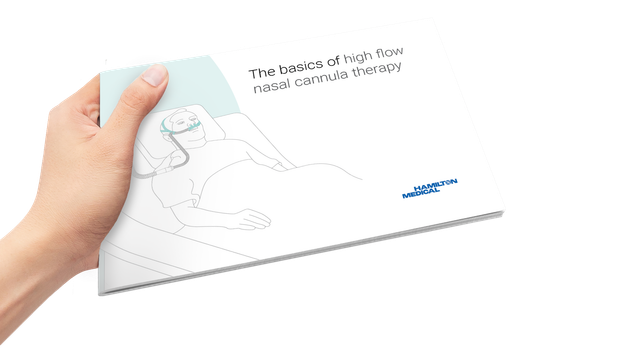
作者: Aude Garnero,监护医师,Sainte Musse 医院,Toulon,法国
日期: 04.05.2021
高流量氧疗 (HFT) 是一种无创的呼吸支持形式,可以降低急性低氧性呼吸衰竭 (AHRF) 病人的插管率和死亡率 (1)。出于对医务工作者接触的担忧,最初的建议不鼓励新冠肺炎病人使用 HFT (2, 3)。

然而,由于早期有创机械通气导致的高发病率和死亡率 (
HFT 对急性低氧性呼吸衰竭的生理影响是公认的,但没有专门针对新冠肺炎的生理数据 (
通过在呼气期间从上气道冲洗呼出的空气来冲洗生理死区,提高了通气效率。HFT 通过降低呼吸频率和解剖死区来减少获得生理动脉二氧化碳水平所需的分钟通气量。因此,肺泡通气(分钟通气量减去死区通气量)保持稳定,而分钟通气量减少。HFT 还可以减少病人的吸气努力和呼吸代谢功。最后,与传统氧气治疗相比,HFT 改善了呼吸力学指标,即动态顺应性、跨肺压和通气均质性,并增强了病人的舒适度和耐受性。
在一项回顾性观察性研究中 (
一项多中心队列研究 (
这两项研究表明,新冠肺炎病人可以通过减少对机械通气的需求及其持续时间,以及在不对医院死亡率产生负面影响的情况下缩短 ICU 住院时间,受益于 HFT。然而,没有随机对照试验比较 HFT 病人使用常规氧疗和早期插管的结局。
三项观察性研究提供了接受 HFT 治疗的新冠肺炎病人的数据。插管率在 36% (
数据显示,HFT 成功的病人在开始 HFT 后的呼吸频率低于随后需要插管的病人 (
ROX(呼吸频率氧合)指数是根据评估呼吸衰竭的呼吸变量计算得出的,因此可用于预测对有创通气的需求。它表示 SpO2/FIO2 与呼吸频率的比值。在非新冠肺炎引起的急性低氧性呼吸衰竭中,ROX 指数可确定 HFT 衰竭风险较低的病人,在 HFT 治疗 12 小时后测量的临界值为 4.88 (
大多数关于新冠肺炎 HFT 的研究要么是实验性的,要么是在健康受试者身上进行的,因此没有反映真实生活。世界卫生组织委托进行审查,以研究 HFT 使用的证据:分析了六项针对非新冠肺炎病人的模拟研究和一项交叉研究;与典型的剧烈呼气病人相比,HFT 不会增加气溶胶扩散的风险;HFT 的气溶胶产生水平和颗粒物数量浓度与鼻塞、非重复呼吸吸氧面罩和自主呼吸相似 (
从一名接受 HFT 和无创通气 (NIV) 的新冠肺炎病人的隔离室采集的环境拭子样本中,有一半显示阳性结果。然而,所有空气样本均为阴性。在四分之一的地点发现了活病毒。这些发现突出了使用个人防护设备的必要性 (
在美国一家医院测量了实施 HFT/NIV 前后新冠肺炎感染的发病率。结果显示,新冠肺炎病人使用 HFT 与使用适当的个人防护设备和群组预防措施相关时,不会导致医务工作者新冠肺炎感染的明显增加 (
清醒状态俯卧位 (PP) 治疗可以改善通气-灌注的不匹配,并通过充分排痰打开不张肺区。两项描述性研究报告了接受 HFT 联合 PP 治疗的新冠肺炎病人的数据。在一项对 10 名病人的研究中 (
在一项前瞻性多中心、调整后的队列研究中 (
HFT 已用于新冠肺炎相关性 AHRF,对氧合状态有良好影响。那些 HFT 失败的病人死亡率更高,因为他们在基线时病情更重。ROX 指数可以作为插管的预测指标,但最佳临界值仍未确定。如果使用适当的防护设备和预防措施,HFT 不会增加医务工作者的污染或感染风险。HFT 和 PP 联合治疗需要进一步研究。
Hamilton Medical 哈美顿医疗公司的所有呼吸机都提供高流量氧气治疗作为标准或可选功能。不需要额外的设备或呼吸机,并且可以根据需要通过改变界面和简单地切换模式来交替使用无创通气进行治疗。HAMILTON-H900 加湿器现在还提供一种特殊的高流量氧气治疗模式,该模式具有专门的设置,可支持所有病人群体的高流量氧疗。
完整引文如下: (
Ventilators from Hamilton Medical offer high flow oxygen therapy as a standard or optional feature (
The HAMILTON-H900 humidifier now also offers a special high flow oxygen therapy mode with dedicated settings to support high flow oxygen therapy for all patient groups.
Full citations below: (

我们的高流量鼻导管治疗电子书向您概述了工作原理和临床获益,以及有关选择正确连接界面、调整设置和监测病人的实用信息。